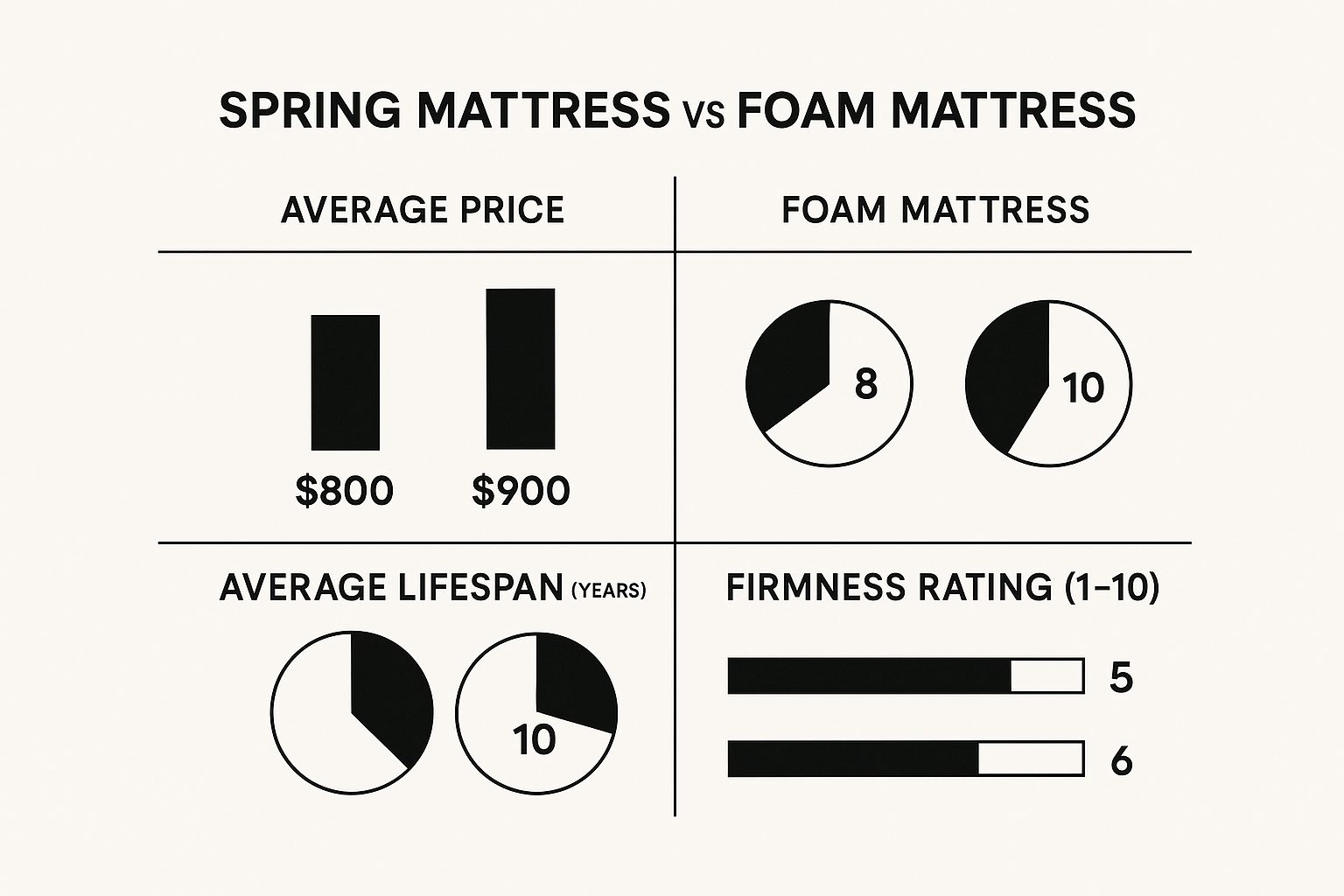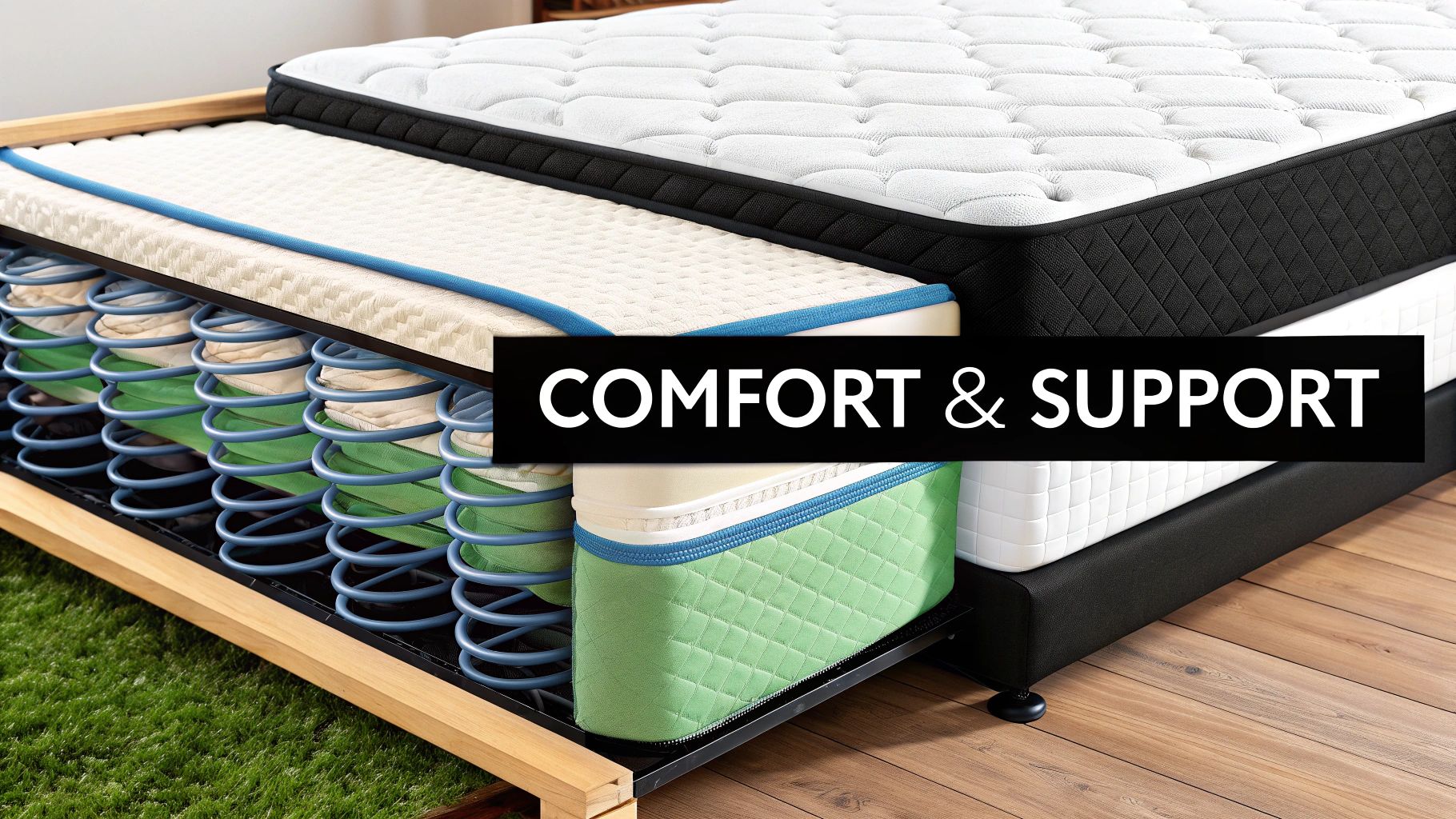Ever wonder if you’d sleep better on a cloud or a trampoline? Choosing between a spring mattress vs foam mattress is a bit like that. It’s the single most important decision you'll make for your sleep quality. Spring mattresses offer that classic, bouncy feel with great airflow, while foam mattresses are famous for hugging your body and stopping partner disturbance.
This guide cuts through the confusion. We'll give you clear, practical insights to help you decide which mattress will give you the deep, restorative sleep you deserve.
Spring vs Foam: Your Quick Comparison
Let's be honest, picking a new mattress can feel overwhelming. The first major choice is usually between spring and foam, as they offer completely different sleep experiences. This table gives you a snapshot of the core differences to help you see which type might be a better fit.
At a Glance: Spring vs Foam Mattresses
| Attribute | Spring Mattress | Foam Mattress |
|---|---|---|
| Feel | Bouncy and responsive. You feel like you're sleeping on the mattress. | Contouring and pressure-relieving. You feel like you're sleeping in the mattress. |
| Support | Firm, uniform support delivered by a network of steel coils. | Targeted support that moulds to your body's unique shape and weight. |
| Motion Isolation | Lower. Movement can travel across connected coils. | Excellent. The foam absorbs movement, making it ideal for couples. |
| Temperature | Sleeps cooler. The open coil structure allows for better airflow. | Can retain heat, though modern foams often include cooling gels. |
| Best For | Hot sleepers, stomach sleepers, and those who love a traditional firm feel. | Side sleepers, couples, and people needing superior pressure relief for joints. |
As you can see, there’s no single "best" option—it's all about what works for you.

For example, a family might grab an affordable spring mattress for a guest room that gets occasional use. In contrast, someone with persistent hip pain would likely invest in a memory foam mattress for its incredible, long-lasting pressure relief.
Understanding these key differences is the first step toward finding your perfect mattress.
What Defines a Spring and Foam Mattress

To settle the spring mattress vs foam mattress debate, you have to look inside. A mattress's internal construction dictates how it feels, supports you, and performs night after night. The inner workings of a spring mattress are a world away from a foam one, creating two completely distinct sleep experiences.
Let's pull back the layers.
The Anatomy of a Spring Mattress
At the heart of a spring mattress is a system of steel coils designed to provide support and that classic, bouncy feel.
There are two main types you’ll come across:
- Bonnell Coils: These are traditional, hourglass-shaped springs linked together. They offer solid, firm support and are common in budget-friendly mattresses. The downside? Because they’re connected, movement on one side is felt across the entire bed.
- Pocketed Coils: A more modern design where each spring is individually wrapped in its own fabric pocket. This allows each coil to move independently, responding directly to pressure without disturbing the springs around it.
Real-world example: Imagine your partner tosses and turns. With Bonnell coils, their every move sends a wave across the mattress. On a bed with pocketed coils, their movement is isolated to their side, letting you sleep peacefully.
Understanding Foam Mattress Construction
Foam mattresses use layers of foam to create a surface known for its body-hugging comfort and excellent pressure relief. "Foam" is an umbrella term for a few key materials.
The Different Types of Foam
- Memory Foam: The star player for contouring comfort. It reacts to your body heat and pressure, softening and moulding to your shape. This makes it fantastic at relieving pressure on joints like hips and shoulders, which is why it’s a top pick for side sleepers.
- Polyfoam: Often used as a support layer beneath memory foam or in more basic foam mattresses. It’s more responsive and has a quicker bounce-back than memory foam. High-density polyfoam creates a durable and supportive base.
- Latex Foam: Made from the sap of rubber trees, latex foam has a more buoyant feel. It provides contouring pressure relief but with a faster response time, so you feel like you're sleeping on the mattress, not sinking into it. For more on natural materials, our guide to non-toxic bedding has more detail.
The Importance of Foam Density
Foam density is a measure of durability, not firmness.
- Low-Density Foam: Feels soft but is less durable and prone to developing body impressions quickly.
- High-Density Foam: Firmer, more supportive, and built to last. A high-density foam core is a sign of a quality mattress that will go the distance.
Even the best mattresses wear out. Our guide on how long mattresses last can help you know when it’s time for a change. And if your mattress just needs a refresh, check these signs it’s time to replace your mattress topper.
Finding the Right Support for Your Sleep Style
Proper mattress support is key to keeping your spine aligned and waking up pain-free. The spring mattress vs foam mattress choice really comes down to how each one supports you based on your preferred sleeping position.
Let's see how each mattress type stacks up for different sleepers.
Support for Back Sleepers
Back sleepers need to maintain the spine's natural S-curve. This requires a mattress that’s firm enough to stop the hips from sinking but soft enough to cushion the lower back.
A pocketed spring mattress often achieves this balance perfectly. The coils push back to create a firm, responsive base that keeps your hips level with your shoulders, preventing the "hammock effect" that causes lower back pain.
Cushioning for Side Sleepers
Side sleeping puts a lot of pressure on your shoulders and hips. This is where foam, especially memory foam, truly shines.
Memory foam contours to your shape, spreading your body weight evenly to relieve pressure points. It allows your shoulders and hips to sink in just the right amount, keeping your spine in a straight, neutral line. A traditional spring mattress can feel too hard for side sleepers, creating sharp pressure points instead of cushioning them.
Real-world scenario: A side sleeper with broad shoulders on a firm spring mattress will find their spine curves awkwardly. On memory foam, the mattress gives way around the shoulder, letting it sink in comfortably while the spine stays straight.
Stability for Stomach Sleepers
Sleeping on your stomach can strain your back if your midsection sinks too deep, forcing your spine into an unnatural arch. Stomach sleepers almost always need a firmer surface.
A firm spring mattress is usually the winner here. The strong coil system provides consistent, even support across the mattress, which stops your hips from dipping and prevents lower back strain. While very firm foam exists, a solid innerspring is often a safer bet for stomach sleepers.
How Your Body Weight Makes a Difference
Your weight plays a huge role in how a mattress feels.
- Lighter Individuals (under 60kg): Often find firm spring mattresses don't compress enough to relieve pressure. A softer foam mattress usually provides better contouring.
- Heavier Individuals (over 100kg): Need a robust support system to prevent sagging. This means looking for high-density foam layers or a spring mattress with a reinforced, high-gauge coil system.
These diverse needs are reflected in the Australian mattress market, which was valued at around USD 208 million. While springs are still popular, foam and hybrid models are gaining ground as people focus more on ergonomic benefits. Learn more about Australian mattress market trends.
How They Actually Perform: The Nitty-Gritty of Sleep
Beyond construction, the real test of a mattress is how it performs night after night. The spring vs foam mattress debate gets interesting when we look at motion isolation, temperature regulation, durability, and edge support. These practical differences will make or break your sleep quality.

Motion Isolation
If you share a bed, you know the struggle of a restless partner. Motion isolation is how well a mattress absorbs movement on one side without transferring it to the other.
Foam mattresses are the clear winners. The dense, energy-absorbing structure of memory foam swallows movement whole.
Real-world example: Your partner gets out of bed. On a foam mattress, their movement is completely localized. The foam compresses under them and slowly bounces back, creating barely a ripple. You’ll sleep right through it.
Traditional spring mattresses are notoriously bouncy. While modern pocketed spring designs are a huge improvement, they still can't match the dead-still quiet of a quality foam mattress.
Temperature Regulation
Waking up hot is a common sleep complaint. How well a mattress breathes is a big deal, especially if you're a hot sleeper.
Spring mattresses have a natural advantage. The open coil system allows air to move freely, carrying body heat away and helping you stay cool.
Foam mattresses historically trapped heat. However, modern foams have solved this with cooling technologies like:
- Gel-Infused Foam: Pulls heat away from your body.
- Open-Cell Structures: Engineered to be more "airy" and breathable.
- Copper or Graphite Infusions: Conductive materials that draw heat away.
For another layer of cooling comfort, check out our breathable bamboo sheet sets.
Durability and Lifespan
A mattress is a big investment. Both spring and foam can last for years, but they break down differently.
Spring mattresses can suffer from coil fatigue, where springs lose their bounce and start to sag. Foam mattresses face body impressions, where the foam softens and fails to spring back. The key to long-lasting foam is density. High-density foams are far more resilient and resist sagging for much longer. To extend the life of any mattress, consider one of our feather and down mattress toppers.
Edge Support
Edge support refers to how sturdy the perimeter of the mattress is. Strong edges make it easier to get in and out of bed and prevent that feeling of rolling off.
Spring mattresses generally come out on top. Most are built with a reinforced perimeter using thicker coils or a firm foam encasement, creating a solid edge.
Foam mattresses are naturally more compressible, which often means softer edges. While many premium models now include reinforced perimeters, they rarely match the rock-solid feel of a well-made innerspring. Curious if it's time for a new bed? See our guide on how long mattresses should last.
Your Health, Wallet, and the Planet
Choosing a mattress is also an investment in your well-being. It pays to think about how each type stacks up on health, price, and environmental impact.
Let’s dig into what really matters.
Health and Hypoallergenic Properties
If you have allergies, your mattress can be a friend or a foe. Foam mattresses really shine here.
The dense structure of memory foam makes it difficult for allergens like dust mites and pet dander to thrive. There just aren't as many nooks and crannies for them to hide in. Someone who wakes up congested on an old innerspring might notice a huge difference after switching to a dense foam mattress.
A common concern with new foam is off-gassing—that "new mattress smell" from volatile organic compounds (VOCs). Look for a CertiPUR-US® certification, which confirms the foam is made without harmful chemicals. For a completely healthy setup, check out our ultimate guide to non-toxic bedding.
Price and Long-Term Value
At first glance, spring mattresses often seem cheaper. A traditional innerspring can be a great budget-friendly option.
However, a low price doesn't always mean the best value. A well-made, high-density foam mattress may cost more upfront but often lasts longer, saving you money in the long run by delaying replacement.
Australians buy around 2.5 million mattresses a year, and foam models are taking up more of that share as consumers prioritise durability and health benefits. You can discover more insights about the Australian mattress market on IndexBox.io.
Environmental Considerations
As more of us make sustainable choices, the environmental impact of a mattress is a key factor.
- Spring Mattresses: The steel coils are recyclable, but separating them from fabric and foam layers is difficult and costly. As a result, most end up in landfill.
- Foam Mattresses: Standard foams are petroleum-based. However, greener options like natural latex foam, made from the sap of rubber trees, are renewable and biodegradable.
Because recycling is a challenge for all mattresses, one of the most sustainable choices you can make is to buy a durable, high-quality mattress that will last a decade or more.
Which Mattress Should You Choose

When it comes to the spring mattress vs foam mattress debate, the best mattress is the one that's best for you. This final summary will help you connect what you've learned with what you actually need.
Let's break it down into straightforward advice.
Your Quick Decision Guide
Think about what you dislike most about your current mattress and what your dream sleep feels like. This will likely point you in the right direction.
Go for a Spring Mattress if: You sleep hot and prefer a classic, responsive bounce. If you're a stomach sleeper or need strong edge support, the firm, breathable structure of a quality pocket spring mattress is a perfect match.
A Foam Mattress is for you if: You're after deep pressure relief or share a bed with a restless partner. For side sleepers needing extra cushioning for shoulders and hips, the body-hugging contour and exceptional motion isolation of memory foam is hard to beat.
Final Thoughts Before You Buy
The Australian mattress market, valued at nearly USD 910 million, is shifting towards specialised options like foam as people become more health-conscious. This shows a willingness to invest in the right sleep solution. Learn more about Australian mattress market growth.
Remember, a quality mattress is a long-term investment in your health. No matter which type you lean towards, consider its expected lifespan to ensure you're getting genuine value. We dive deeper into this in our guide on how long mattresses should last.
Conclusion: Your Perfect Sleep Awaits
Choosing between a spring and foam mattress doesn't have to be complicated. By focusing on your personal sleep style, body type, and priorities—whether that’s cooling airflow, pressure relief, or motion isolation—you can confidently pick the right foundation for a great night's sleep.
You now have all the information needed to make an informed choice. The final step is to create a sleep environment that brings you comfort and calm.
Explore our collection and build your ultimate sleep sanctuary today!

